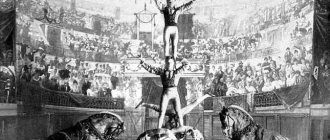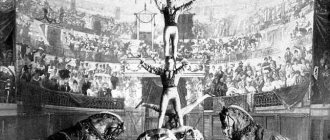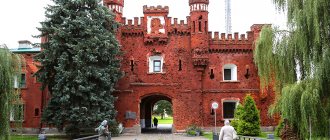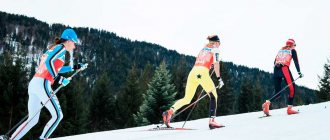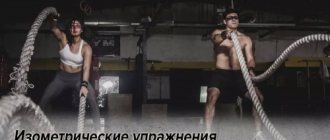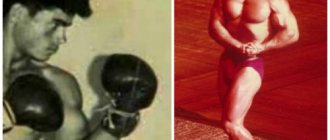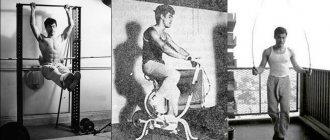Isometric exercises are exercises in which there is no movement in the joints, the muscles are tensed in a certain position, reaching maximum effort for 6-10 seconds, after which they relax. For such exercises, objects that cannot be lifted, broken, bent or torn are suitable.
Alexander Zass, the founder of this method, used chains and iron rods for these purposes, and at the very beginning of his career he tried to lift an unbearably heavy barrel. To develop not only strength, but also muscle mass, combine static exercises with dynamic ones in your training.
In this book you will learn about the systemic complexes of isometric exercises by Alexander Zass.
The athlete believed that muscle volume is not an indicator of strength, and tendons are largely responsible for strength, which are developed with the help of isometric (static) exercises.
The essence of the training system
“Iron Samson” promoted a special training system, which implied the development of strength and tendon strength, as well as strength endurance. For example, he performed a circus trick with a horse, hoisted the animal onto his shoulders, and made a circle around the circus arena. If a horse weighs on average 400-500 kilograms, then the strongman himself weighed 75 kilograms with a height of 167 centimeters.
The only source of knowledge about his training method is the autobiographical book of Alexander Zass. This book was published in 1925.
Short biography. The birth of the power of Iron Samson
Little Sasha was born on February 23, 1888, in the family of a simple peasant. He was the third child in a family of seven people: father Ivan Petrovich, mother Ekaterina Emelyanovna and two more brothers and two sisters Alexander. They lived in the Vilna province of the Russian Empire, on a small farm without a name.
Childhood, youth and circus
Soon after Sasha's birth, the whole family moved to Tula, and then to Saransk, since Ivan Petrovich received the position of clerk. The landowners' estates, which were managed by his father, were located between Saransk and Penza.
The management of bank accounts and household management was completely taken over by the purposeful and strong-willed Ekaterina Emelyanovna. The entire life of the Zassovs was arranged in such a way that each family member worked constantly, as hard as he could. From memories it is known that the family did not need, there was plenty of food and drink, but all this was obtained through hard, incessant work.
Alexander’s childhood was not full of interesting events, but his father had high hopes for his son: he trusted him with the transportation of large sums of money to be credited to a bank account and saw Sasha as a locomotive driver in the future. His father was ready to provide him with a good technical education, but the boy himself was not drawn to this profession.
The soul of the future athlete strived for bright, enchanting circus performances.
One day, after a successful transaction for selling horses at a fair, Ivan Petrovich went with his son to a performance of a traveling circus. The spectacle deeply shocked Sasha with its festive splendor. I especially liked the strongman who bent an iron rod around his neck and easily juggled heavy weights.
The incredible sharpness and intensity of the emotions received at the performance did not allow Sasha to fall asleep that evening. And then he committed a terrible crime - he ran away from the room at the inn where he and his dad spent the night and, at his own expense, watched the artists perform again.
After such disobedience, the father severely punished his son and then sent him to work as a shepherd in a remote village. The boy was 12 years old when he learned to manage large herds of horses, cows and camels, and also gained undeniable authority among six ferocious and capricious wolfhounds, who obeyed him well in his work.
Thoughts about the circus did not leave Alexander all this time. He learned to shoot well, protecting the herds from predators. mastered the basics of training, teaching horses circus tricks. All this was useful to him later.
Returning to Saransk, Sasha began studying the biographies of famous gymnasts, athletes and circus performers. His idol was Evgeniy Sandov, the most famous strongman of the 19th century.
The boy enthusiastically collects literature on the development of physical capabilities and body strength, studies the works of famous athletes, masters exercises using available materials: wood, stones, and carries a calf on his shoulders.
And although Sashenka was a weak, sickly child as a child, regular exercise brings significant benefits to the health and endurance of the body. he feels his muscles strengthen and his body’s strength capabilities expand.
When Alexander turned 20, his father sent him to Orenburg to study as an assistant driver. At the same time, the famous Andrzhievsky circus comes to the city on tour and, of course, the young man goes to the performance.
The boundless love for the circus, the skills acquired through regular training and the desire to realize his lifelong dream add courage to Alexander. And he turns to the director of the circus with a request to hire him. To his surprise, he receives approval with the explanation that for now he will only be hired as a laborer and his life will be very difficult. But the future artist, hardened by difficulties, is not afraid of obstacles on the way to his dream and goes to work in the circus.
At the new place, Sasha does the hardest “menial” work. He meets and begins to help the athlete Kuratkin prepare for power routines. With his determination and perseverance, Zass earned the sympathy of the strongman and he teaches the young man the wisdom of circus performances.
Thanks to self-training and competent mentoring, the young man begins to perform in the arena within a few months.
In the future, Alexander Zass will perform in the Yupatov and Khoitsev circus, constantly improving his athletic abilities.
War, captivity and escapes
The outbreak of the First World War suspended the development of the career of the great strongman. And, after mobilization, Alexander Ivanovich Zass was enlisted in an infantry regiment, and then in reconnaissance, where he made mounted raids behind enemy lines.
He turned out to be a skilled and fearless warrior, his developed fighting qualities and skills ensured a quick promotion, and his brave deeds were legendary.
Thus, the story of how Alexander brought a wounded horse back to his regiment was very popular.
But we didn’t have to fight for long. In the battle, the athlete was seriously wounded and captured. Doctors wanted to amputate both of his legs, but the indecisiveness of the doctors and regular passive exercises from the personal system made such an operation completely unnecessary.
The prisoner, thanks to incessant training, left to his own devices, learned to walk again. After some time, he not only walked on crutches, but also helped care for other patients.
Four escapes from captivity speak of the great perseverance and fortitude of the Russian hero. Each time, overcoming any obstacles, Alexander found himself free and tried to get to his people. Three times he was caught, and, after severe punishment, he was returned to hard work or imprisonment. And only on the fourth time, we managed to break free completely.
Life in Europe and circus acts
Having suffered in the war and in captivity, Alexander Ivanovich decided that there was no place for a soldier of the tsarist army in Soviet Russia and remained in Europe. In the early 20s of the last century, the athlete took the pseudonym Samson, under which he performed in the Schmidt Circus. With his unique abilities he won worldwide fame and enormous popularity among the European public.
He performed briefly in Paris, then at 24 he received an invitation from Oswald Stoll, the head of British variety shows. Having moved to England, he settled there until the end of his life.
Throughout his life, Alexander Ivanovich Zass studied and analyzed the physical capabilities of the human body. He tested his knowledge in practice, proving by personal example the effectiveness of the exercise systems he used, and now we can apply his wealth of experience in improving our body.
Principles of the technique
- The emphasis is on developing tendon strength, strengthening ligaments, not muscles.
- Tendon strength is developed by performing isometric exercises.
- Tendon training should last longer than muscle development training.
- To develop tendons in training, you need to continuously maintain tension.
It is worth clarifying that despite the fact that the athlete simply loved to perform isometrics, he also did not disdain strength exercises and devoted enough time to muscle development.
Breathing and concentration
Unlike modern strength techniques, Alexander Zass paid a lot of attention to proper breathing and concentration.
Many experts note the similarity of this aspect with yoga training and other eastern methods of self-improvement, where human breathing plays a key role.
Through various breathing techniques, adepts are taught to control the vital energy Qi.
By consciously directing Qi energy to different parts of the body, you can achieve phenomenal development of physical qualities - strength, flexibility, endurance. By the way, this is exactly what the Shaolin monks demonstrate.
It is not known for certain whether Zass was familiar with Eastern esoteric knowledge. It is quite possible that he intuitively came to similar views.
Alexander Zass believed that strength development consists of 4 components:
- Strength of will
- Proper breathing when performing strength exercises
- The ability to manage and control your muscles
- Strong tendons
Before starting training, Zass recommended focusing as much as possible. At the same time, try to forget about all stress, completely devoting your attention to training.
The focus should not be on breaking the chain, but on improving your body.
Zass believed that throughout training one must constantly learn to feel and control the flow of energy and strength. Which over the years will lead to complete mental control over your muscles.
His breathing recommendations differ from those generally accepted in strength sports. He recommended doing all isometric exercises while inhaling.
It was prohibited to do Zass tendon exercises with holding your breath.
Example workout
Alexander’s training consisted of two phases, namely:
- Tendon exercises (isometric).
- Dynamic movements (for muscle development).
Heavy chains were my favorite athletic equipment for isometric work. I would like to emphasize that this strongman performed isometric exercises using serious weight.
Techniques with chains are aimed at “breaking” them. There are movements for the legs, and there are for the arms.
Alternatively, here are a few examples from his program.
Exercise No. 1.
Take the chain at shoulder width. Straight arms are placed in front of the chest. The load is produced by moving the arms with the chains to the side. The goal is to break the chain.
Exercise No. 2.
Hold the chain above your head with your hands. Extend your arms to the sides. The goal is to stretch the chain.
Exercise No. 3.
Place the chain behind your back, holding it tightly against your back. The arms are slightly bent. The goal is to break the chain.
Exercise No. 4.
Wrap the chain around your chest as you exhale, and as you inhale, use the force of your chest to break the chain.
Exercise No. 5.
Wrap the chain around your chest as you exhale. As you inhale, using the strength of your thoracic region, try to break the chain.
Exercise No. 6.
With your feet on the chain, holding it with your elbows bent, pull the chain up with your hands. The goal is to break the chain.
“Iron Samson” himself said that these exercises do not work for everyone and this approach is more individual than dogmatic.
Before performing exercises with chains, the athlete should warm up the entire body.
When performing isometrics with chains, all muscles should be involved in the work, and not just the main ones involved in the work.
The static force must be built up gradually and very smoothly.
For a beginning strongman, to perform one exercise, it is enough to create tension for five seconds. The duration of the effort must be increased gradually.
The number of approaches for each exercise is from 1 to 3.
The time for rest between approaches is selected individually.
The goal of the exercises is maximum and synchronous tension of the muscles of the whole body.
Video of exercises on the methods of tendon development by Alexander Zass:
Chains are sold in hardware stores.
Handles can be made like this: take two pieces of pipe of a convenient thickness and thread a wire (or cable) into them, bent at the connection into a hook. Leg loops are very important, as they provide comfort for the most powerful tensions of the body (for example, in the atlas pose). Ask ladies you know about old handbags, try using tarpaulin or material for trunks. But first, experiment with the fabric: step on it with your foot and pull its ends up: evaluate the thickness, width, and comfort of the loop. You can use the loops in conjunction with slippers.
